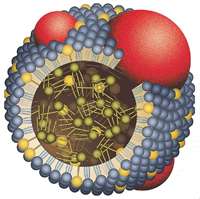HDL is known as the "good cholesterol": it lowers the chance of developing cardiovascular disease. Some families display naturally high levels of HDL in their blood. Research on the underlying causes of genetically high HDL cholesterol is important for the development of new medicines that can increase HDL levels in the blood.
A specific receptor that mediates the uptake of cholesterol from HDL by the liver is essentially required for the atheroprotective function of HDL. This is shown in a study published in the Jan. 13 issue of the New England Journal of Medicine 2011 of Theo van Berkel and Miranda van Eck of the division of Biopharmaceutics of the Leiden/Amsterdam Center for Drug Research (LACDR) and Jan-Albert Kuivenhoven of the department of Vascular Medicine of the Academic Medical Center (AMC) in Amsterdam. This paper was further discussed in a two-page article in the leading Dutch daily newspaper “NRC Handelsblad” on January 15.
“Good” and “Bad” Cholesterol
Cholesterol is extremely insoluble in water. For transport in the blood it therefore forms, together with other lipids, “fat balls” called lipoproteins. The two best known lipoprotein variants are HDL (high-density lipoprotein) or ‘good’ cholesterol, and LDL (low-density lipoprotein) or ‘bad’ cholesterol. Too much LDL in the blood can contribute to the development of cardiovascular disease and atherosclerosis. High levels of HDL on the other hand protect against cardiovascular disease.
HDL: trucks for the “Good” cholesterol
Atherosclerotic lesion development is initiated by the accumulation of cholesterol from LDL in macrophages of the arterial wall. HDL exerts its protective function by removing excess cholesterol from macrophages in the arterial wall and transporting it to the liver, where it can be excreted from the body. HDL thus performs this clean-up by acting as a garbage truck, picking up its garbage in the arterial wall and transporting it to the liver.
Medicines for treating atherosclerosis lower the “bad” LDL cholesterol. For many patients, however, this is not sufficient to prevent the development of cardiovascular disease. Thus, there is an important need for new drugs. Extensive research is being done on strategies to increase the transport of cholesterol via HDL to the liver.
Importance of the HDL receptor for the protective function of HDL
Research at the Division of Biopharmaceutics of the LACDR has focused for more than 10 years on the function of the receptor for HDL, SR-BI. In mice this receptor is essential for the delivery of HDL cholesterol to the liver. Mice that lack this receptor accumulate large amounts of HDL cholesterol in their blood, but still rapidly develop extensive atherosclerosis as HDL cannot function properly. Until now the importance of SR-BI for HDL metabolism in humans was unknown.
Research in families with genetically high HDL cholesterol
The department of Vascular Medicine of the AMC has a large database with families with extreme levels of serum cholesterol: very high and very low. In the DNA of a family with high HDL cholesterol a mutation was discovered in the gene that codes for the HDL receptor SR-BI. The mutation in SR-BI leads to a high HDL cholesterol level in the blood and proves that SR-BI is also essential for the uptake of HDL cholesterol in humans. Similar as previously found in studies with mice lacking SR-BI, persons with a mutation in SR-BI were not protected against the development of atherosclerosis. In addition, similarly as in SR-BI deficient mice, the function of platelets in the blood as well as the production of steroid hormones by the adrenals was affected. Cholesterol is an important backbone for the production of steroid hormones. “For long it was thought that LDL – the bad cholesterol that also contributes to the development of atherosclerosis – is used by the adrenals for steroid hormone synthesis. Our study, however, shows that in humans the adrenals also need cholesterol derived from HDL. For the uptake of cholesterol from HDL by the adrenals a good function of the HDL receptor SR-BI appears to be essential.”
Translational research
This study is a textbook example of translational research, one of the leading research profiles of Leiden University, in which fundamental knowledge is translated to the clinic. The researchers from the AMC focused on the analysis of the DNA of families with high HDL-cholesterol in the circulation and the clinical consequences of the SR-BI mutation. In Leiden, the study focused on the biochemical research and the functionality of the mutated receptor. The findings of the combined studies are of major importance for research on HDL medicines aimed at improving HDL function to decrease the risk for cardiovascular disease.
Provided by Universiteit Leiden


















